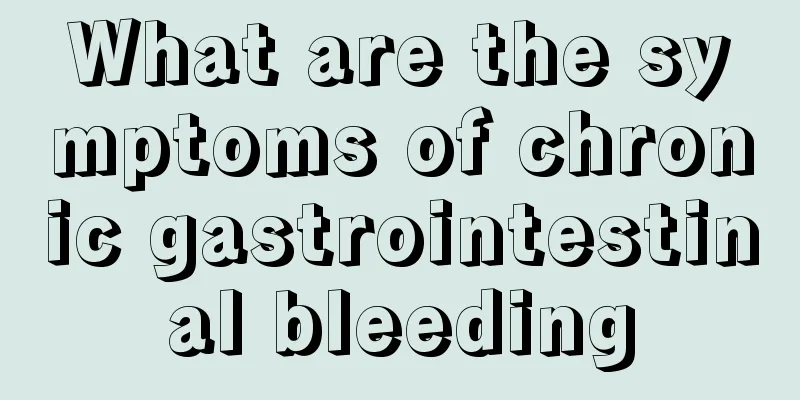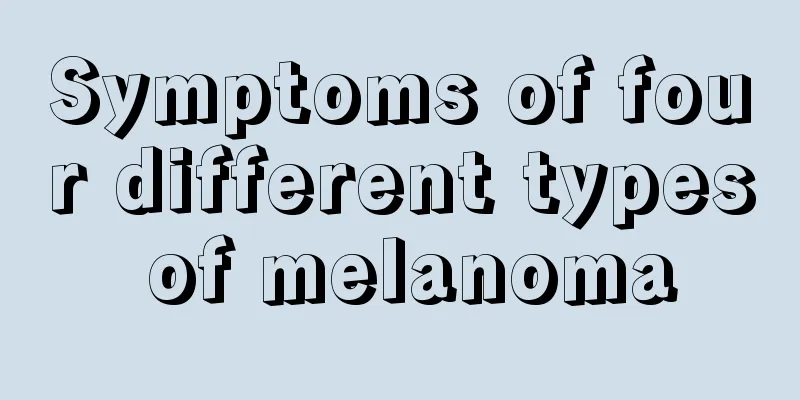What are the symptoms of chronic gastrointestinal bleeding

|
Chronic gastrointestinal bleeding is a very serious disease. The incidence rate is relatively high among the elderly. Once such a phenomenon occurs, you must go to the hospital for treatment, otherwise your own digestive ability will gradually decrease. Therefore, we need to have a detailed understanding of the symptoms of chronic gastrointestinal bleeding. Let us briefly understand its symptoms below! There are many symptoms of upper gastrointestinal bleeding in the elderly. Clinically, elderly people with upper gastrointestinal bleeding will experience dizziness and nausea. Elderly patients with upper gastrointestinal bleeding have symptoms of blackouts and syncope. 1. Bleeding 1. Vomiting blood (1) It can be seen in esophageal bleeding, gastric bleeding, duodenal bleeding, and jejunal bleeding after gastrojejunostomy. Vomiting of blood may occur when bleeding from the above sites is accompanied by vomiting, reflux or obstruction. (2) Color: Bleeding from esophageal varicose veins is usually dark red. If it mixes with gastric juice and is vomited out, it will be coffee-colored. Bleeding from the stomach or duodenum is vomited out and is coffee-colored. If the amount is large and cannot be fully mixed with gastric juice, it will be dark red or bright red. 2. Blood in the stool (1) Black stools: ① It can be seen in upper gastrointestinal bleeding, jejunal, ileal, or right colon bleeding that is slow to be discharged. ②Properties: Typically, the blood is black, shiny, sticky, and tarry. If the amount of bleeding is small and mixed with stool, it may appear as dark brown stool to varying degrees. The stool appears tarry when concentrated and dark red when dispersed by water. This condition can be seen in patients with heavy upper gastrointestinal bleeding, but can also be seen in lower gastrointestinal bleeding. (2) Dark red blood in stool: This is often seen in bleeding from the colon, jejunum, or ileum. It can also be seen when the amount of upper gastrointestinal bleeding is large and is discharged quickly. (3) Bright red blood in stool: ① Blood dripping or spurting after defecation, seen in anorectal bleeding ② A small amount of bright red blood in stool, or a small amount of bright red blood attached to the surface of stool, seen in anorectal or right colon bleeding ③ A large amount of bright red blood in stool, in addition to bleeding in the anus, rectum, and left colon, can also be seen in the right colon or even small intestine, when the amount is large and discharged quickly. (4) Mixed blood in stool: ① Jam-like stool, stool and blood are evenly mixed, which is more common in right-sided colon bleeding, such as amoebic dysentery; ② Mucous blood in stool or mucous pus and blood in stool, which is more common in left-sided colon bleeding, such as ulcerative colitis, bacillary dysentery, etc. (5) Positive fecal occult blood test: Slow, small amount of bleeding, no obvious change in the appearance of the stool, only the occult blood test is positive. In addition, sometimes even if there is a large amount of bleeding, it may stay in the digestive tract for several hours without being discharged, and there will be no vomiting of blood or blood in the stool, which can easily lead to misdiagnosis. (II) Circulatory system manifestations 1. Compensatory manifestations of the circulatory system may include tachycardia and other symptoms. When the blood is not discharged, it is easy to mistake it for a symptom of the original heart disease and delay treatment. 2. Manifestations of insufficient blood supply to important organs: The elderly often have underlying diseases such as cerebral arteriosclerosis and coronary heart disease. Bleeding causes insufficient blood supply to important organs such as the heart, brain, and kidneys. Angina pectoris, arrhythmia, dull heart sounds, dizziness, amaurosis, syncope, apathy, confusion, decreased urine volume, etc. may occur, which can easily lead to misdiagnosis when the blood is not discharged. 3. Manifestations of peripheral circulatory failure: Massive bleeding from the digestive tract causes a rapid decrease in circulating blood volume, which can lead to peripheral circulatory failure, with symptoms such as dizziness, palpitations, thirst, amaurosis, cold and clammy skin, collapsed surface veins, fatigue, listlessness, irritability, slow reaction, tachycardia, and low blood pressure. 4. Anemic heart changes Long-term and repeated gastrointestinal bleeding causes severe and persistent anemia, which can cause corresponding changes in the heart, such as heart enlargement. (III) Blood picture 1. Anemia after blood loss ① It can be seen in acute large-scale bleeding or long-term repeated bleeding ② After acute bleeding, anemia usually occurs more than 3-4 hours later ③ It is a normocytic normochromic anemia, and macrocytic anemia may occur temporarily ④ The reticulocyte count may increase within 24 hours of bleeding, and can be as high as 5%-15% 4-7 days after bleeding, and then gradually returns to normal. 2. White blood cell count increases: 2-5 hours after massive bleeding, the white blood cell count may exceed 10×109/L, and will return to normal 2-3 days after the bleeding stops. (IV) Others 1. Azotemia: ① Enterogenic, caused by the absorption of blood protein decomposition products. Blood urea nitrogen increases several hours after bleeding and reaches a peak within 24-48 hours. Most of the time, it does not exceed 6.7mmoI/L and returns to normal after 3-4 days. ② Prerenal, caused by a temporary decrease in renal blood flow, it can quickly return to normal after shock is corrected. ③ Renal, caused by renal failure accompanied by oliguria or anuria, and it is difficult to return to normal before renal failure is corrected. 2. After fever and massive bleeding, most patients may develop a low fever within 24 hours. 3. Depending on the cause and degree of bleeding, there may be complications such as acute renal failure, infection, and hepatic encephalopathy. Bleeding can also aggravate existing lesions of the heart, brain, kidneys and other organs, leading to corresponding clinical manifestations. The above are some symptoms of chronic gastrointestinal bleeding. It is often difficult for patients to treat after suffering from this type of disease. Therefore, the elderly must have a detailed understanding of the prevention measures and symptoms of chronic gastrointestinal bleeding. Once they find that they have the symptoms, they must go to the hospital for treatment. |
<<: How to treat stage 4 melanoma
>>: What are the clinical manifestations of acute enteritis?
Recommend
What to do if you have a cough caused by influenza
Influenza outbreaks occur frequently during the S...
What are the risk factors for thyroid cancer
What are the predisposing factors for thyroid can...
What are the dangers of smoking and drinking
We all know that if we want to have a healthy bod...
Chinese medicine formula for lung cancer metastasis to bone cancer
If a cancer patient has been diagnosed with metas...
What are the hazards of conjunctivitis
The occurrence of conjunctivitis will inevitably ...
Can people with polycystic kidney disease eat pineapples? What fruits can people with polycystic kidney disease eat?
Spring is the best season to eat pineapples, but ...
The best 24-hour detoxification schedule for the body
5-7 am: Colon detoxification time If the large in...
What should I do if my hands itch and get blisters?
I felt my hands were itchy, so I scratched them a...
How to calibrate a blood glucose meter
With the improvement of people's living stand...
What to do if calluses appear on your hands
In daily life, we cannot avoid doing some rough, ...
How to store live crabs
Crabs are actually quite hardy creatures. We hard...
What causes shoulder and back pain
In a busy life, many people are prone to shoulder...
Can swimming treat high blood pressure?
People now have a higher standard of living and e...
What to do if you have nosebleeds due to liver cancer? Pay attention to these points
After getting cancer, many patients will become d...
What are the symptoms of thoracic diaphragmitis?
Pleural septitis is caused by tuberculosis infect...









